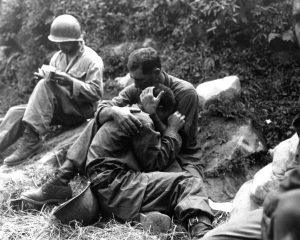One of the most notable pictures that comes to mind when thinking about a military course is a drill instructor yelling and belittling a poor private for not completing a task properly. Hardly the modern learning environment we see today, right? How could the notion of empathic design ever be thought to be a viable means to design courses in an institution like the Armed Forces? Before opinions and attestations occur, a basic understanding of empathic design is required.

A grief stricken American infantryman whose buddy has been killed in action is comforted by another soldier. In the background a corpsman methodically fills out casualty tags, Haktong-ni area, Korea. August 28, 1950. Sfc. Al Chang. (Army)
NARA FILE # 080-SC-347803
WAR & CONFLICT BOOK #: 1459
Empathic design is the melding of the exploration of feelings and moods with the realm of instructional design (Mattelmaki, Vaajakallio & Koskinen, 2014). It focuses on “everyday experiences and on individual desires, moods, and emotions in human activities and turning such experiences and emotions into inspiration” (Mattelmaki, Vaajakallio & Koskinen, 2014, p. 67). Empathic design contrasts the mainstream cognitive design approaches we mostly see around us…those approaches that display “design as a problem-solving engagement” as opposed to “an interpretative exercise through an interaction with people leading to innovative design” (Mattelmaki, Vaajakallio & Koskinen, 2014, p. 68). Why empathic design one may ask? The answer is simpler than you think. Objective design through problem-solving, combined with cognitive theory most definitely has its place. However, it becomes difficult for instructional designers to tackle some problems purely from the cognitive design mentality. Empathic design principles allow for a rich collaborative design approach and creates a type of sensitivity to design. It is ‘sensitive’ to humans, the design itself, techniques and collaboration as a whole (Mattelmaki, Vaajakallio & Koskinen, 2014). This type of sensitivity design brings stakeholders together in a collaborative sense and also fosters to develop the instructional designer’s abilities during the design process. This unique approach could lead to innovative processes and ideas during the design process.
The opinion: Overall, empathic design could have a role in the military context, but only to an extent. Modern warfare would easily dictate where empathic design is not necessary. Does a military commander, when training his troops to charge the enemy with bayonets take an empathic approach to design? Indoctrination training practices has arguably, some necessary place in the Armed Forces. However, there are many types of courses within the military that have little to nothing to do with direct enemy force close-in-combat learning. As an officer within the Canadian Armed Forces, many courses within the topic of leadership and communications may benefit from such as approach. In end, the simple answer is I believe it would work for some courses and not for others. Just one Officer’s opinion of thousands.
Mattelmaki, T., Vaajakallio, K., & Koskinen, I. (2014). What happened to empathic design? Design Issues, 30(1), 67-77. doi: 10.1162/DESI_a_00249
Photograph: August 28, 1950. Sfc. Al Chang. (Army, 111-SC-347803)
December 10, 2019
Really interesting perspective Mark, thank you for sharing. I have no military background, so pardon my humble opinion, but in combat training, and in consideration of wartime traumas, such as PTSD, should instruction not include strong components of empathetic design? Enemy aside, what about self-nurturance and wellness for the training soldiers? Is a culture of silence and lack of empathy an issue?
Again, thank you for sharing!
December 22, 2019
Hey Lisa,
Sorry for the later response. Its important to note that the military does have many ’empathic designed’ typed courses (at least in my experience). Wellness and self-nurturance is also highly incorporated in many aspects of a soldier’s training as well. The military however, has always had indoctrination type training. Whether acceptable or not, the training is designed to prepare soldiers to fight in the midst of overwhelming stress and to follow orders at all times, even if it is to charge the front lines of a deeply entrenched enemy. The indoctrination methods are meant to give soldiers, albeit, a rote ability to engage an enemy under heavy duress or heavy enemy fire. In the heat of the battle, the military needs soldiers to follow orders, even if those orders may influence their demise. War is cruel and chaotic. My overall point in my above blog was to state that specific training, where combat skills, that being kill or be killed, require a rote mentality to follow orders and follow your training. This will help ensure mission success and the greater success of your fellow soldier surviving as well. Again though, many courses in the military emphasize empathic design principles. It just isn’t for everything. It is always a contentious and highly debated topic , on how to train combat arms? Just one opinion of many. Thanks for your thoughts again. Cheers, Mark